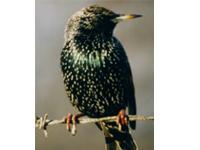
Starlings were introduced intentionally in New York over a hundred years ago. Since then, they have spread in population and area. These birds may produce two clutches of offspring per year, each with four to seven offspring.
Starlings feed on a variety of substances. They will readily feed on seeds but have a particular preference in spring and summer for invertebrate animals such as insects in their larval stages (grubs). They will readily forage in open trash containers and will eat spilled food in parks and picnic sites. Starlings will roost or rest in trees and consume fruit, making themselves a major agricultural fruit pest.
Starlings can be found in nearly every setting from agriculture to metropolitan areas. They have a tendency to travel in flocks and will commonly be found grazing in short grass. Common in residential settings, the starlings will occupy trees or will be found perching on gutters, which may be clogged and filled with water. These clogged gutters provide a much needed water source for the starlings.
Starling droppings may cause components of steel buildings to degrade and lead to significant structural damage. A potential health risk arises from soil enriched with starling droppings, which can promote fungal growth and lead to diseases, such as histoplasmosis. In addition, starlings are also known for bird strikes of aircraft, causing at least one crash with fatalities.